An introduction to reloading - Part 1
Factory loaded ammunition has probably never been as good as it is today. So what's the point of trying to make cartridges yourself, especially if you're an amateur? NORMA's reloading specialist, Lukasz Dzierzanowski, will try to explain this.
Is reloaded ammunition or factory loaded ammunition better?
Wise old people in my country often say, that "you can’t always control the wind, but you can control your sails.” The field of hunting equipment is no exception to this. With more and more precise, ergonomic, reliable and faster rifles as well as more technical aids such as range finders, wind meters, apps and hi tech scopes, we expect to control the intrinsic world of ballistics in order to hit the target more accurately, harder and deadlier.
But even as factory loaded ammunition has become better in quality, more specialized, fine-tuned and consistent, there is still a vast field of ballistics which the shooter just doesn’t control – if you don’t start hand loading yourself.
Will you achieve a better result each and every time? I doubt it. Factory loaded ammunition today offers consistency, variety and quality which is difficult to surpass. Also, hand loading your ammunition might have many advantages, but you must remember that only by being patient, careful and sticking to the rules, you can achieve excellent and, most importantly, safe results.
And finally - you have to ask yourself: what does "better" actually mean? It's very relative. There will probably be as many needs and the resulting criteria as there are shooters and hunters. And this is most likely the reason why factory ammunition, even if perfect, will not necessarily be ideal for everyone at the same time. It is very similar to the topic of clothing, you can get a great suit of the rack, but there’s a chance that you will benefit from a made-to-measure approach.
So let's go back to the original motivation and the title question. The term “reloading” is inseparably connected with the word “adjustment”. The custom fitting takes place in different dimensions: the application, the gun and last but not least the shooter himself.
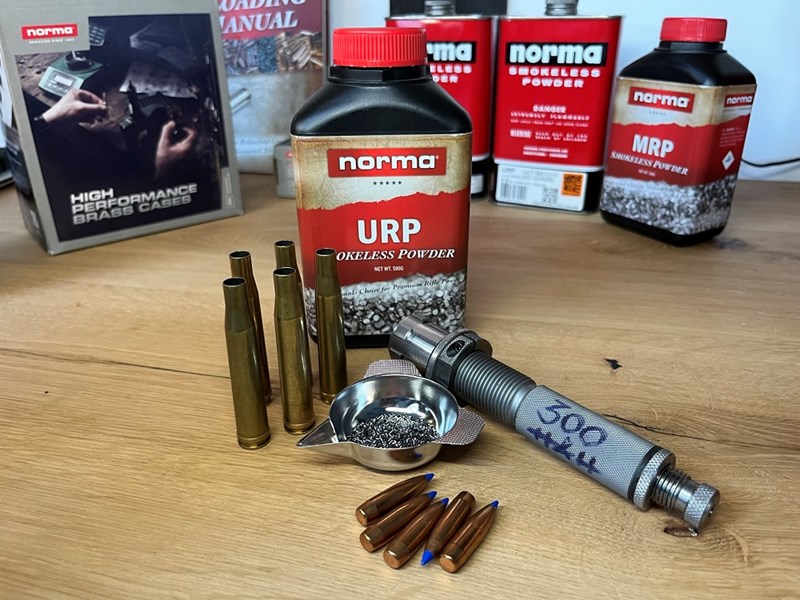
Reloading brings all calibers to life
Reloading brings endless combinations
First of all - the reloader has great freedom in choosing components. For the popular 30-06, you could choose from hundreds of different bullets weighing anything from 100 to 240 grains. And in the vast majority of coun-tries, they could be ordered online (even internationally) and delivered by post. The ammo availability crisis we've experienced recently shows how difficult it can be to get the exact factory load we're after. Such a large selection of bullets allows you to take into account various aspects related to hunting - the type of game, the typical distance at which the shot will be fired, field conditions and more.
A reloader will also keep a close eye on all aspects of the bullet performance – accuracy, expansion, penetra-tion, energy transfer, resistance to obstacles etc. This approach leads in the long run to increased awareness of ballistics and marksmanship. Firstly, by better understanding the phenomena that accompany shooting, and secondly, by the need to visit the shooting range more often. On the other hand – it is often the curiosity that leads a shooter or hunter to reloading in the first place. The freedom of being able to personally select the bullet and muzzle velocity often not available in the factory loads is both tempting and educative.
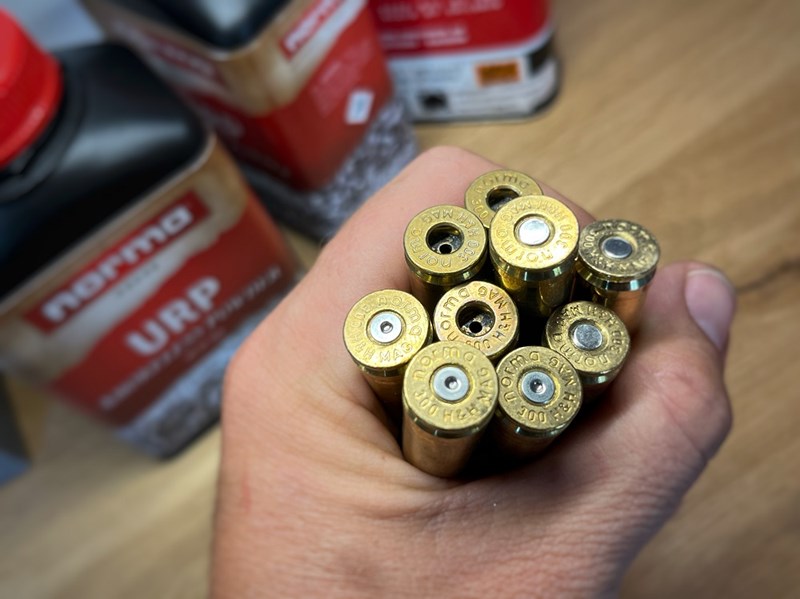
You actually reload the brass - it's a good idea to invest in a quality material.
Reloading offers the opportunity to use the cartridges many times
In the case of popular calibers, the variety of own cartridges may not be a sufficient argument for the hunter. Things are completely different however, when it comes to the obscure ones. Reloading is sometimes the only possible way to enjoy hunting with guns chambered in rare calibers.
My friend's old drilling in the pre-war 9.3x82R, despite its very good technical condition, waited a long time for the moment when it could speak again in the woods. After many years of silence, the new dies and some old brass found in a forgotten box in the basement brought it back into hunting service. And gave a great joy to its owner.
Who would have thought that American hunters-reloaders, stereotypically associated with cowboy hats and lever-action guns, would change the fate of the noble English double rifles? In the early 1970s, when ammuni-tion in the Nitro Express calibers family began to disappear, some of the old gun slowly became useless. At that time, only reloaders with used cases and custom-made dies were able provide the right ammunition. The value of some fancy doubles dropped drastically and they become more and more affordable for a wider group of buyers. This eventually led reloading equipment manufacturers to introduce these calibers into their lineup. And this, in turn, meant that after 30 years or so, the old calibers returned to favor and found their place in the factory offer.
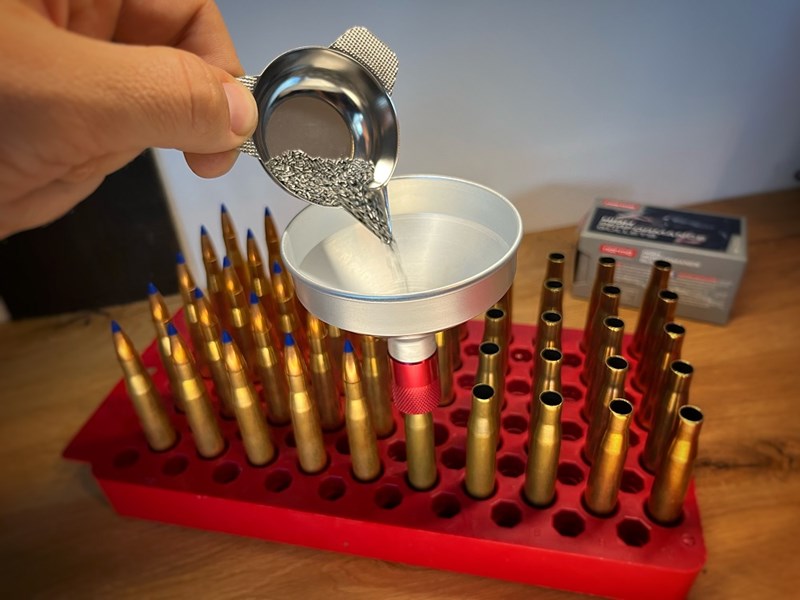
Staying focused - all cases have to be filled with equal charge of powder
Playing with speed
One of the parameters of the cartridge that is greatly influenced by the reloader is the initial velocity. By limit-ing (to the extent allowed) load and the powder type, you can significantly slow down the bullet, creating a "light" ammo. With the exception of a few offerings, almost all factory loads use the full potential of the caliber. And for a good reason - most hunters expect this. But faster is not always better. Sometimes, when hunting for short distances, high speeds might be problematic.
There are no technical limitations that would make it impossible in ballistic terms to reduce a magnum caliber of e.g. 300 Weatherby Magnum to the level of 308 Winchester. Speeds of 800 m/s will be enough in most cases, allowing for much more pleasant shooting - but there will always be the possibility to accelerate a typical bullet by 150-200 m/s if necessary. Self-reloading significantly increases the possibilities of using your weapon for various purposes.
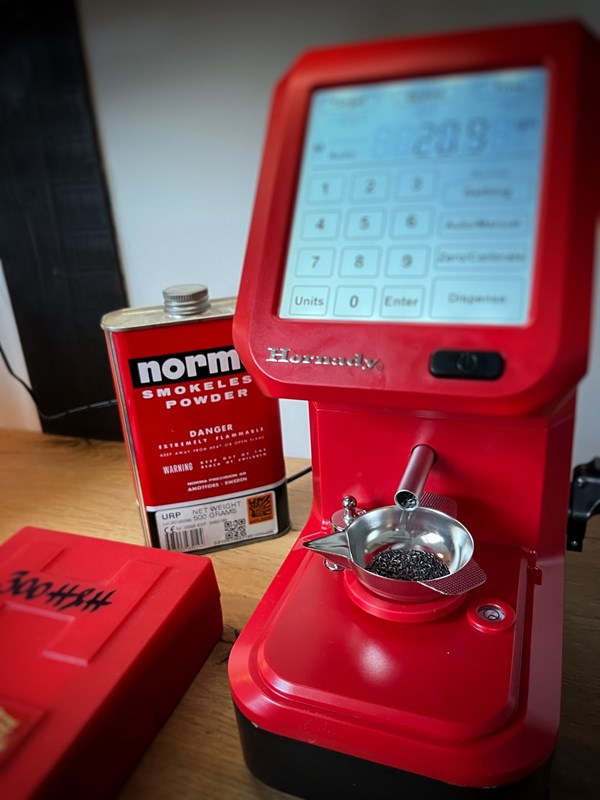
Weighing the powder is a crucial process. The load has to be carefully selected and then measured with a precise scale.
The ammunition is made to fit
You can’t question the quality and consistency of premium ammunition these days. Most of the guns out there will shoot great groups with it. Most does not mean all of them, unfortunately. We've all probably gone through it - when the theoretically perfect cartridge didn't want to get along with a particular gun, especially if the barrel has an odd twist rate (different than the CIP specification), not exactly standard cartridge chamber dimensions or has been altered (e.g. shortened).
The procedure by which cartridges are manufactured on an industrial scale must ensure that the majority of available firearms produce satisfactory grouping on the target. This effect depends not only on the care with which it is produced - it largely depends on the recipe: the type of powder, the weight and the depth of em-bedment of the bullet. So it will necessarily be some kind of averaging - the goal is for as many weapons as pos-sible to shoot well with this ammunition. However, there will always be those that will not cooperate, and there's nothing you can do about it. The ordinary hunter will have to test many different products and some-times come to terms with the fact that in the end it is the barrel that will choose the cartridge and not him.
The philosophy of reloading by definition rejects the existence of "universal recipes" - and leads to the selec-tion of a bullet, powder and primer for a specific unit. Developing your own recipe significantly increases the chances of success.
In conclusion reloading means freedom. You choose not only the components but define all of the cartridge parameters. You can adapt the cartridge to your hunting style, not the other way around.
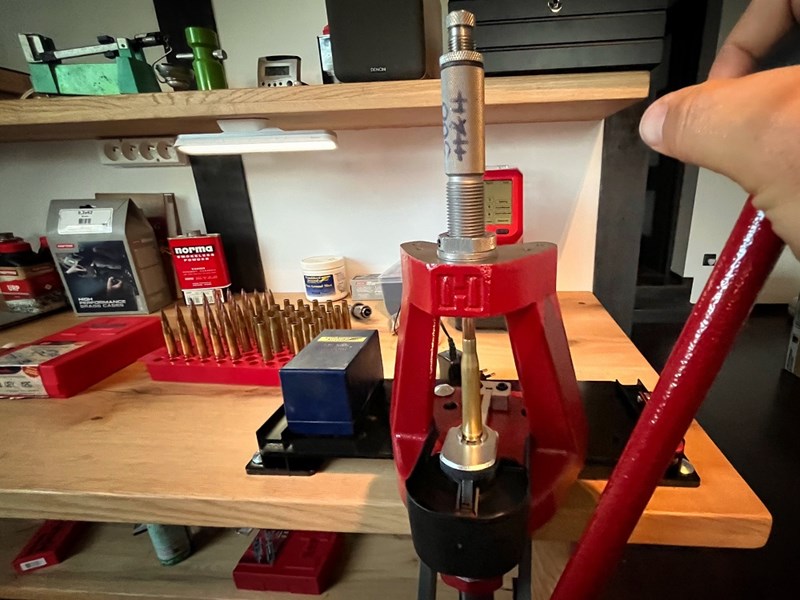
Seating the bullets is the last step of the actual reloading process. Then it's all about testing at the range and using the ammo in the field.
Last but not least- it's fun!
I left the most important argument for last. I first became aware of it when I accidentally stumbled across ste-vepages.com - a website ran by Stephen Ricciardelli and devoted to the subject of reloading. The experienced author explained that in the 1960s he used to reload because it was cheaper. In the 70's his cartridges were faster than the factory. In the 80's, he believed they were more accurate. More reliable in the 90's. And after that purely because doing it by yourself was a lot of fun.
It's been almost 20 years since I’ve been making my own cartridges. And I tend agree with Steve more and more. I do not reject factory premium ammunition - I trust it no less than my own production. But I like to know everything about my cartridges and wish to be able to influence everything.
I am a strong believer, that at the end of the day, the satisfaction of getting a good result at a shooting competi-tion, or being able of harvesting game in the woods with my own ammo, gives that small but significant added value to the joy experienced at the time. And isn't joy what our passion is all about after all?
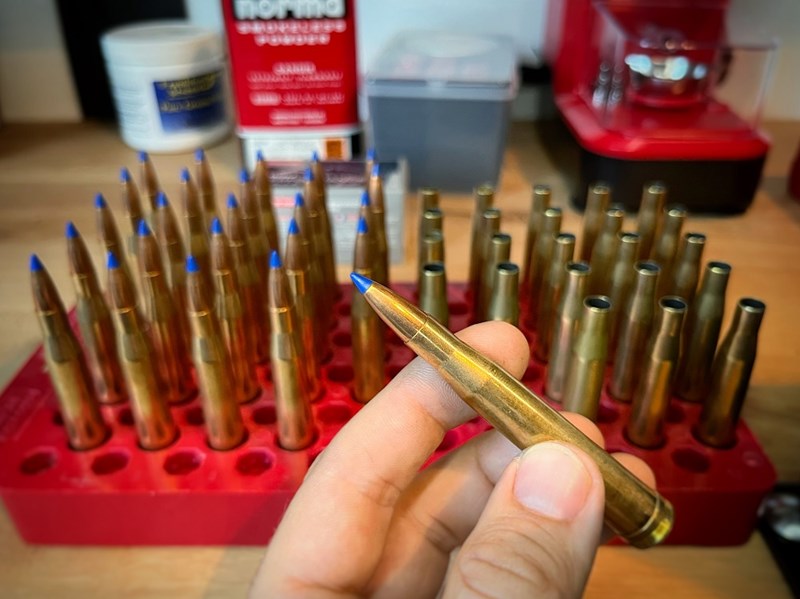
An old cartridge brought to life with a modern bullet. Bondstrike and 300H&H is a wonderful combo!